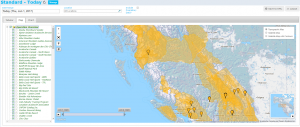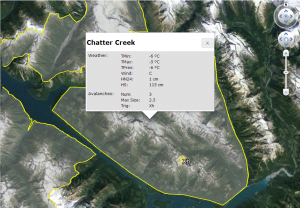Map view layer: Operation overview
Jump to navigation
Jump to search
| REQUIREMENTS | |
| Permission | All users |
| Connectivity | Online only |
This document describes the functionality of the Operation overview layer of the Map view of the InfoEx report.
The goal of the Operation overview map layer is to provide user with quick access to summarized information from individual Infoex subscribers and context about where the observations in the current report are coming from.
Layout
The operation overview map layer shows the operation areas of all of the operations that contributed observations and assessment to the present InfoEx report as yellow outlines (Fig. 1).
All of the contributing operations are listed under the Observation overview label in the layer hierarchy panel left of the map (Fig. 1).
Functionality
- Double-click on the operation name in the layer hierarchy panel to directly zoom the map to its operation area and open the observation overview pop-up balloon.
- Click on the check box next to the operation name in the layer hierarchy panel to show/hide the outline of its operation area on the map.
- Click on the operation area of an operation on the map to view the observation overview pop-up balloon (Fig. 2). The pop-up balloon currently offers the following information:
- Weather:
- Tmin: Lowest minimum temperature recorded at weather site by this operation during the time period of report.
- Tmax: Highest maximum temperature recorded at weather site by this operation during the time period of report.
- Tpres: Latest present temperature recorded at weather site by this operation during the time period of report.
- Wind: Latest wind observations recorded at weather site by this operation during the time period of report.
- HN24: Latest HN24 observations recorded at weather site by this operation during the time period of report.
- HS: Latest HS observations recorded at weather site by this operation during the time period of report.
- Avalanches:
- Num: Total number of avalanches observed by this operation during the time period of report. This is different from the total number of avalanche observations. The following conversions have been used to convert categorical to numerical values: Isolated (2), Several (7), Numerous (12).
- Max Size: Absolute highest avalanche size (size typ or size max) reported by this operation during the time period of report.
- Trig: List of avalanche triggers reported by this operation during the time period of report.
- Weather:
Related documents
- Operation overview
- Avalanche observations
- Avalanche hazard
- Snow Profiles
- Field summary
- Weather observations
- Time slider (used for all map layers)
- Additional external information sources
Functionality tested by
- Jan. 2, 2014: Pascal Haegeli

